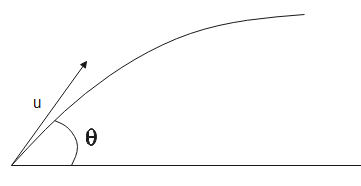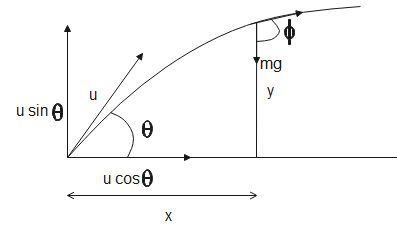
Answer
420.3k+ views
Hint: The motion of a body is the resultant of one or more forces acting on it. In a projectile motion, the body has motion in horizontal as well as vertical direction. Resolving the velocity into its components and applying equation of motion, we can determine the path followed by the body
Formula used:
$x=u\cos \theta t$
$s=ut+\dfrac{1}{2}a{{t}^{2}}$
Complete step-by-step solution:
According to Newton’s second law, a body undergoes acceleration when a force acts on it, therefore,
$F=ma$
Here, $F$ is the force acting on a body
$m$ is the mass of a body
$a$ is the acceleration of the body
In a projectile, the path followed by the body is given as

Here $u$ is the initial velocity of the body. The force acting on the body should not be parallel or anti-parallel, let $\phi $ be the angle between initial velocity and force, then, $\phi \ne 0$ or $\phi \ne {{180}^{o}}$
In a projectile no force is acting in the horizontal motion therefore, the horizontal velocity remains constant. In the vertical direction, the force of gravity acts on the body hence, the acceleration is constant. The FBD diagram of the body in projectile motion is

The force acting on the particle is $mg$ and acceleration in the vertical direction is equal to g.
Let x be the distance covered along the horizontal axis, then
$x=u\cos \theta t$ - (1)
Let y be the distance covered along the vertical axis. Applying equation of motion along vertical axis we get,
$s=ut+\dfrac{1}{2}a{{t}^{2}}$
Here, $s$ is the distance covered
$t$ is the time taken
$a$ is acceleration
Substituting given values in the above equation,
$y=u\sin \theta t-\dfrac{1}{2}g{{t}^{2}}$
Substituting $t$ from eq (1)
$\begin{align}
& y=u\sin \theta \dfrac{x}{u\cos \theta }-\dfrac{1}{2}g{{\left( \dfrac{x}{u\cos \theta } \right)}^{2}} \\
& \Rightarrow y=x\tan \theta -\dfrac{1}{2}g\dfrac{{{x}^{2}}}{{{u}^{2}}{{\cos }^{2}}\theta } \\
\end{align}$
The above equation represents the equation of a parabola.
Therefore, in projectile motion, the force acting on the body is not in the direction of initial velocity and the path followed is a parabola.
Hence, the correct option is (B).
Note:
Since the force is constant, acceleration is also constant. The velocity becomes zero at the highest point of the projectile and it is maximum at the lowest point. The velocity and force are not in the same direction at any point of the projectile. The force of gravity or mg is responsible for decelerating the body.
Formula used:
$x=u\cos \theta t$
$s=ut+\dfrac{1}{2}a{{t}^{2}}$
Complete step-by-step solution:
According to Newton’s second law, a body undergoes acceleration when a force acts on it, therefore,
$F=ma$
Here, $F$ is the force acting on a body
$m$ is the mass of a body
$a$ is the acceleration of the body
In a projectile, the path followed by the body is given as

Here $u$ is the initial velocity of the body. The force acting on the body should not be parallel or anti-parallel, let $\phi $ be the angle between initial velocity and force, then, $\phi \ne 0$ or $\phi \ne {{180}^{o}}$
In a projectile no force is acting in the horizontal motion therefore, the horizontal velocity remains constant. In the vertical direction, the force of gravity acts on the body hence, the acceleration is constant. The FBD diagram of the body in projectile motion is

The force acting on the particle is $mg$ and acceleration in the vertical direction is equal to g.
Let x be the distance covered along the horizontal axis, then
$x=u\cos \theta t$ - (1)
Let y be the distance covered along the vertical axis. Applying equation of motion along vertical axis we get,
$s=ut+\dfrac{1}{2}a{{t}^{2}}$
Here, $s$ is the distance covered
$t$ is the time taken
$a$ is acceleration
Substituting given values in the above equation,
$y=u\sin \theta t-\dfrac{1}{2}g{{t}^{2}}$
Substituting $t$ from eq (1)
$\begin{align}
& y=u\sin \theta \dfrac{x}{u\cos \theta }-\dfrac{1}{2}g{{\left( \dfrac{x}{u\cos \theta } \right)}^{2}} \\
& \Rightarrow y=x\tan \theta -\dfrac{1}{2}g\dfrac{{{x}^{2}}}{{{u}^{2}}{{\cos }^{2}}\theta } \\
\end{align}$
The above equation represents the equation of a parabola.
Therefore, in projectile motion, the force acting on the body is not in the direction of initial velocity and the path followed is a parabola.
Hence, the correct option is (B).
Note:
Since the force is constant, acceleration is also constant. The velocity becomes zero at the highest point of the projectile and it is maximum at the lowest point. The velocity and force are not in the same direction at any point of the projectile. The force of gravity or mg is responsible for decelerating the body.
Recently Updated Pages
what is the correct chronological order of the following class 10 social science CBSE

Which of the following was not the actual cause for class 10 social science CBSE

Which of the following statements is not correct A class 10 social science CBSE

Which of the following leaders was not present in the class 10 social science CBSE

Garampani Sanctuary is located at A Diphu Assam B Gangtok class 10 social science CBSE

Which one of the following places is not covered by class 10 social science CBSE

Trending doubts
Harsha Charita was written by A Kalidasa B Vishakhadatta class 7 social science CBSE

Which are the Top 10 Largest Countries of the World?

Banabhatta wrote Harshavardhanas biography What is class 6 social science CBSE

Difference Between Plant Cell and Animal Cell

Fill the blanks with the suitable prepositions 1 The class 9 english CBSE

How do you graph the function fx 4x class 9 maths CBSE

The Equation xxx + 2 is Satisfied when x is Equal to Class 10 Maths

One Metric ton is equal to kg A 10000 B 1000 C 100 class 11 physics CBSE

Why is there a time difference of about 5 hours between class 10 social science CBSE



